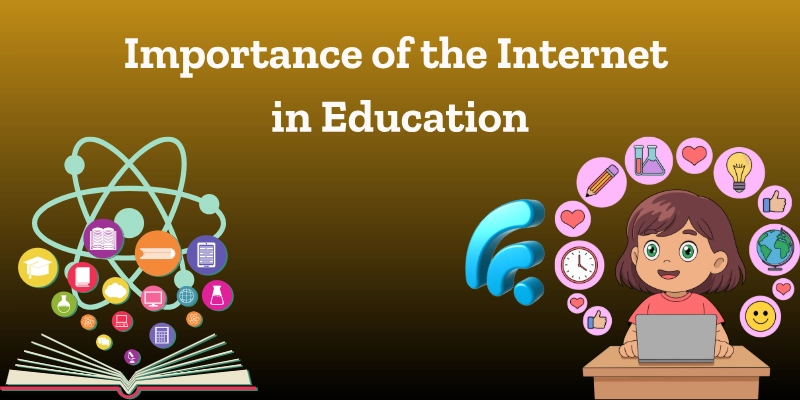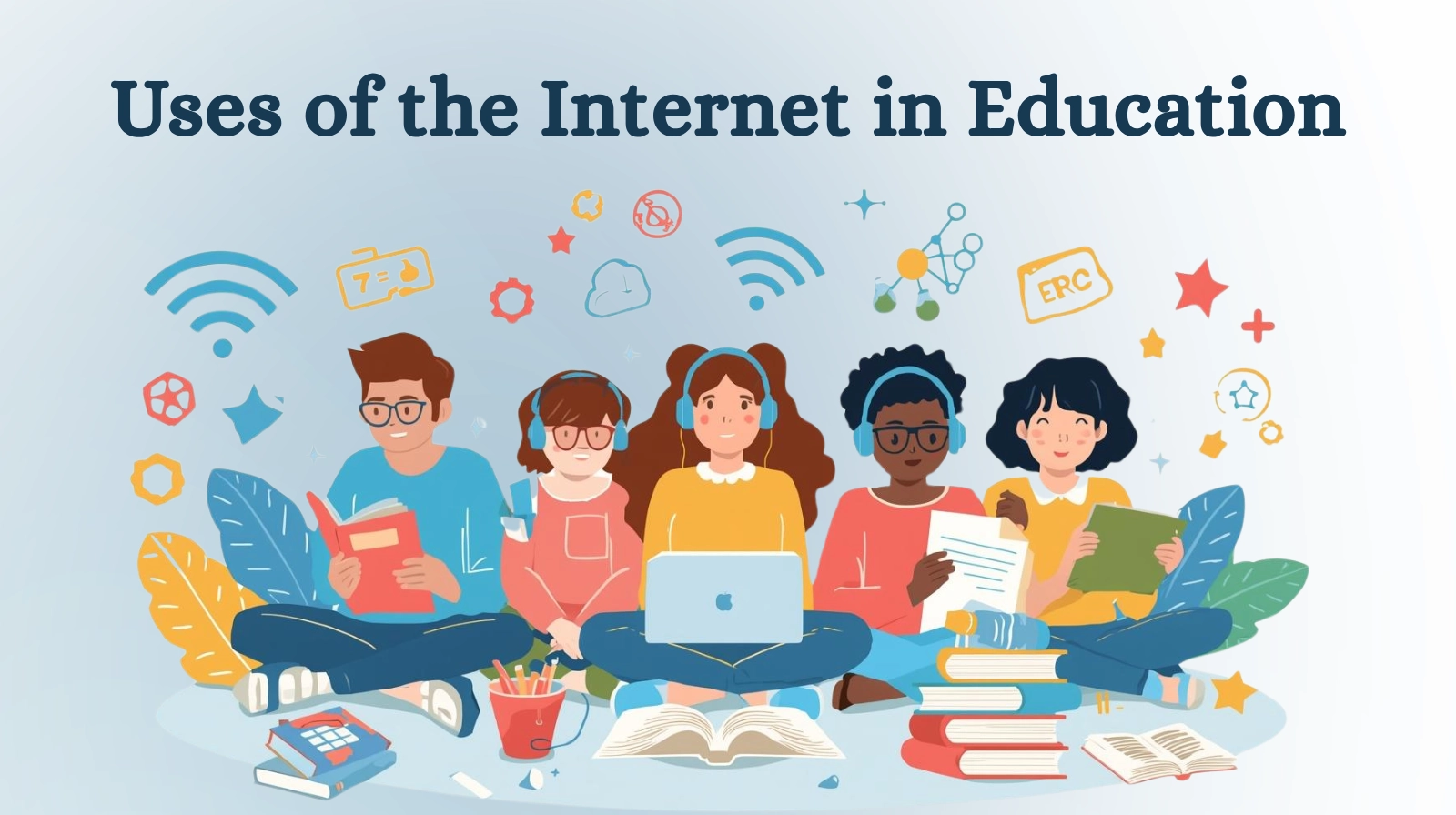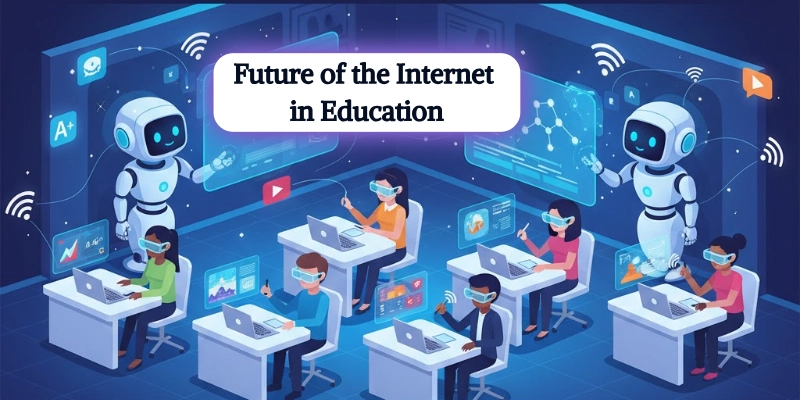Importance of the Internet in Education
Published: 18 Oct 2025
Today, the Internet is more than just a place to watch videos or chat with friends; it has become a classroom without walls. It connects teachers, students, and information from around the world.
The importance of the internet in education is clear, as it has changed traditional learning into digital learning. Students can study anytime, and teachers can share lessons easily.

This article explains the importance of the internet in education, its role, benefits, uses, challenges, and future in modern learning.
What is the Internet in Education?
The Internet in education means using online tools, websites, and digital platforms to teach, learn, and share knowledge. It connects students and teachers through virtual classrooms, videos, and study materials.
In simple words, the meaning of the Internet in education is learning with the help of the Internet instead of only using books or blackboards.
Here are some simple ways the Internet is used in education:
- To attend live online classes from anywhere.
- To watch educational videos and tutorials.
- To download notes, assignments, and e-books.
- To communicate with teachers and classmates through emails or chats.
- To take online tests and submit homework easily.
Example:
When a student attends an online class, watches a YouTube tutorial, or submits homework through Google Classroom, that’s using the Internet in education. It allows learning to happen anytime and anywhere, making studying easier and faster for everyone.
Role of the Internet in Education
The role of the internet in education is to make learning smarter, faster, and easier for everyone. It helps teachers share lessons online and allows students to study from any place at any time. With the use of the internet in learning, education has become more flexible and global.
- Connecting Students and Teachers:
The Internet builds a strong link between students and teachers through tools like emails, video meetings, and classroom apps. Teachers can guide students instantly, and students can ask questions or submit work without being in the same place. - Online Learning and Classes:
With the internet for students, studying no longer needs a physical classroom. Platforms like Zoom and Google Meet make it possible to attend lectures and complete courses from home. This helps students who live far away or have busy schedules continue their studies easily. - Unlimited Knowledge:
The Internet gives students endless learning options. They can explore topics on Wikipedia, watch tutorials on YouTube, or take free lessons on Khan Academy. The use of the internet in learning helps them understand subjects deeply and learn new things beyond school books. - Digital Libraries and Research:
Through digital libraries, students can read eBooks, journals, and research articles anytime. The role of the internet in education also supports higher studies by helping learners collect data, check facts, and write reports using trusted sources online. - Global Learning Opportunities:
The Internet connects classrooms across borders. Students can learn new skills, join international workshops, and talk with teachers from different countries. These global experiences show how the internet for students creates a world of shared education and knowledge.
Advantages and Disadvantages of the Internet in Education
The Internet has changed the way students learn. Knowing the benefits and drawbacks of the internet in education helps students and teachers use it wisely.
| Advantages | Disadvantages |
| Easy access to information | Can distract students |
| Enables distance learning | Not all content is reliable |
| Cost-effective learning | Requires an internet connection |
| Enhances creativity and skills | Reduces face-to-face communication |
| Encourages self-learning | Risk of cyber threats |
The pros of the internet in education make learning faster, flexible, and more creative. However, the cons of the internet in education show the need for careful use, guidance, and safe online habits.
Uses of the Internet in Education
The uses of the internet in education are many. It helps students, teachers, and schools improve learning and teaching in easy and efficient ways.

The Internet is now a key part of education. Its uses in education make learning faster, easier, and more connected for everyone.
Students
Students use the Internet to:
- Search for study materials quickly online.
- Submit homework and projects digitally.
- Learn from educational videos and tutorials.
- Attend online classes from home.
- Prepare for exams using online tests.
Teachers
The internet for teachers makes teaching easier and more effective. Teachers can:
- Share notes, assignments, and lessons online.
- Communicate with students anytime.
- Use digital tools for interactive teaching.
- Track student progress and performance.
- Conduct online assessments and quizzes.
Schools and Colleges
Schools and colleges use the internet to:
- Manage online learning platforms.
- Conduct virtual meetings for staff and students.
- Maintain digital attendance and records.
- Offer e-learning courses for students.
- Organize online events and competitions.
Internet Learning vs Traditional Learning
Many students and teachers want to know the difference between online learning and classroom learning. This comparison between internet and classroom learning shows how each method works.
| Feature | Internet Learning | Traditional Learning |
| Place of Learning | Anywhere with Internet | In classroom |
| Resources | Online materials, videos | Textbooks |
| Flexibility | Anytime, self-paced | Fixed schedule |
| Cost | Often low or free | Requires physical setup |
| Interaction | Virtual via chat or video | Face-to-face |
The online learning vs traditional learning comparison shows that Internet learning is flexible, cost-effective, and accessible from anywhere. Traditional learning offers personal interaction and structured schedules.
Both have their benefits, but the importance of the internet in education makes online learning a popular choice for many students today.
Challenges of Using the Internet in Education
Although the Internet is very useful, it also comes with some problems. Understanding these disadvantages of the internet in education helps students, teachers, and schools use it safely and effectively.
- Internet Addiction:
Students may spend too much time online, which can affect their study habits and focus. - Distraction and Misuse:
Social media, games, and entertainment websites can distract students from learning. - Misinformation:
Not all information on the Internet is accurate. Students must check sources carefully before using them in studies. - Technical Problems:
Slow internet, power cuts, or a lack of devices can make online learning difficult and frustrating. - Privacy and Safety Concerns:
Students must protect their personal data and avoid unsafe websites to stay secure online.
| Challenge | Problem | Solution |
| Internet Addiction | Too much screen time | Set daily limits for online study |
| Distraction & Misuse | Games and social media | Use learning apps and block distracting sites |
| Misinformation | Wrong or fake info | Cross-check sources and use trusted websites |
| Technical Problems | Slow internet or no devices | Schools can provide offline resources or devices |
| Privacy & Safety | Data theft or unsafe sites | Use strong passwords, safe websites, and guidance from teachers |
The challenges of online learning show that students must use the Internet carefully. Awareness of these problems of internet use in schools helps make digital learning safe and productive.
Importance of the Internet for Students
The importance of the internet in students’ lives is growing every day. It helps students learn new things, improve skills, and connect with the world in ways that were not possible before.
- Learning Beyond Books:
The Internet gives students access to modern subjects, trending topics, and global information. They can study beyond textbooks and explore new areas of knowledge. - Encourages Self-Learning:
With interactive lessons and online tutorials, students can learn at their own pace. The internet for students allows them to repeat lessons, practice more, and understand difficult topics better. - Improves Communication Skills:
Emails, chats, and virtual discussions help students communicate clearly and confidently. Online group projects also improve teamwork and interaction skills. - Enhances Creativity:
Students can use digital tools for art, design, coding, and other creative projects. This encourages innovation and thinking outside the box. - Builds Digital Literacy:
The Internet teaches students how to use technology safely and effectively. Learning digital skills early prepares them for future careers and everyday life.
The student benefits of the internet are clear: it makes learning fun, flexible, and connected to the world.
Future of the Internet in Education
The future of the internet in education is exciting and full of possibilities. New technologies are making learning more interactive, personalized, and global.

The digital learning future shows that the Internet will continue to transform education. It will make learning more flexible, creative, and connected to the global community.
- Artificial Intelligence in Learning:
AI-based tutoring systems help students learn smarter. They provide personalized lessons, track progress, and suggest improvements, making the study more effective. - Virtual Reality Classrooms:
Virtual Reality (VR) allows students to explore 3D lessons and real-world environments. This brings subjects like history, science, and geography to life in a fun and interactive way. - Global Online Universities:
Students can now learn degrees and specialized skills from anywhere in the world. Online universities make higher education accessible to everyone, regardless of location. - Smart Learning Apps:
Personalized apps help students practice, revise, and prepare for exams. These apps adapt to each student’s learning style, making studying faster and more efficient.
Tips for Safe and Effective Use of the Internet in Education
Using the Internet wisely is very important for students. Following these tips ensures safe use of the internet in education and helps students study effectively.
- Visit only trusted educational websites: Stick to sites recommended by teachers or schools.
- Set a daily screen-time limit: Balance online learning with offline activities.
- Always verify information sources: Check facts from multiple reliable sites before using them.
- Use parental controls for younger students: Protect children from inappropriate content.
- Avoid sharing personal data online: Keep passwords, addresses, and other personal info private.
Following these rules ensures internet safety for students while making learning productive and enjoyable.
Conclusion
In this article, we’ve learned about the importance of the internet in education. The Internet is now a vital part of education. It helps students learn faster, teachers teach smarter, and schools reach learners worldwide.
With online classes, digital resources, and interactive tools, studying has become easier and more flexible. The importance of the internet in education is clear: it turns traditional learning into a digital, global experience.
With the Internet, the classroom is no longer a place; it’s a world of knowledge in your hands.
FAQs
Have questions about online learning? Find your answers below!
The internet provides easy access to information and learning resources. It allows students and teachers to connect and learn from anywhere.
Students can study anytime using online classes, videos, and tutorials. It also helps them research and complete projects faster.
It allows me to find information quickly and learn new skills online. I can attend classes and watch tutorials without leaving home.
Children can learn new subjects, improve creativity, and practice skills online. It also makes studying more fun and interactive.
Teachers can share lessons, track student progress, and give online assignments easily. It also helps them use digital tools to teach more effectively.
Children use the internet to learn, explore, and complete school work. They also use it to watch educational videos and join online classes.
Yes, technology makes learning faster, easier, and more engaging. It helps students understand concepts better and practice skills effectively.

- Be Respectful
- Stay Relevant
- Stay Positive
- True Feedback
- Encourage Discussion
- Avoid Spamming
- No Fake News
- Don't Copy-Paste
- No Personal Attacks

- Be Respectful
- Stay Relevant
- Stay Positive
- True Feedback
- Encourage Discussion
- Avoid Spamming
- No Fake News
- Don't Copy-Paste
- No Personal Attacks





